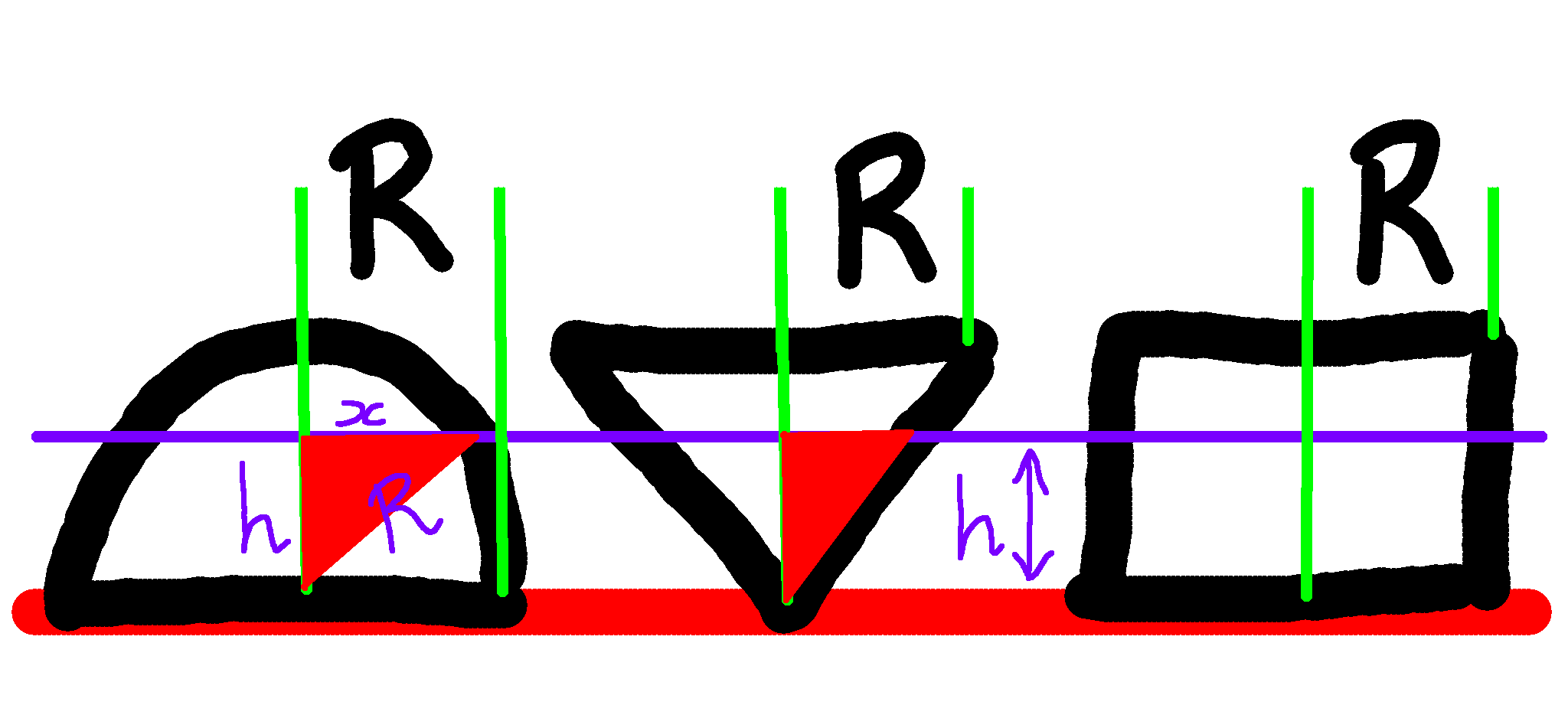Volume of a Sphere
Yesterday (as I type this)
Fermat's Library
on Twitter tweeted this:
|
|
|
It was only 282 years ago that Euler presented
in his textbooks the exact formula for the volume
of a sphere.
|
|
|
Click here to see the original
Then there was an image with the actual formula: $V=\frac{4}{3}{\pi}r^3$.
Over 12 thousand people "Liked" the tweet, but someone said:
- ... how would you go about proving this one?
So here is how we can prove it.
Volume of a cone
Firstly, think about a cube. We can think of the cube as six pyramids
put together with their apexes meeting in the middle. The apex of each
pyramid is in the exact centre of the cube, so if the cube has a side
length of 1, then the pyramids will have to have "height" $\frac{1}{2}$.
Then because there are six identical pyramids we can conclude that each
pyramid is one sixth of the volume of the cube.
- So a square-based pyramid of side length 1 and height $\frac{1}{2}$ has a volume of $\frac{1}{6}$.
Imagine doubling the height of the pyramid. That would double the volume,
so now the volume is $\frac{1}{3}$.
- So a square-based pyramid of side length 1 and height 1 has a volume of $\frac{1}{3}$.
|
A few people have asked about this. Imagine taking your pyramid,
or indeed, and shape, and think of an approximation made up of tiny cubes.
Now double each cube in height. Doing so doubles the volume of each
little cube, and therefore doubles the volume of the whole thing. But
it also doubles its height.
Generalising this argument, we can see that scaling by some factor in
one direction increases the volume by that factor.
You may need to think about that for a bit ... |
Thinking about scaling this vertically:
- If we multiply the height by 5, the volume is now $\frac{5}{3}$;
- If we multiply the height by 8, the volume is now $\frac{8}{3}$;
- If we multiply the height by $h$, the volume is now $\frac{h}{3}$,
- which can also be written as $\frac{1}{3}h$.
Now think about scaling the base. If we make the edges of the base
twice the size, the area of the base is four times the size, and the
volume similarly increases by a factor of 4. Thinking carefully about
this we get the following:
- If the area of the base of a pyramid is $A$,
- and the height is $h$,
- then the volume is $\frac{1}{3}Ah$.
This isn't limited to square-based pyramids, though, it's true of every
pyramid and every cone. Take any shape of area $A$ in the plane, and any
point above it. Join that point to every point on the rim of the shape
to make a cone-like "thing", and the volume of that resulting "thing" is
$\frac{1}{3}Ah$.
Comparing volumes
Consider two identical stacks of coins. The volumes of the stacks are
the same, and this remains true even if you slide some of the coins
sideways to make one of the stacks "wonky".
Using that as our inspiration we introduce "Cavalieri's principle"
which says this:
- Given two things standing on a table, if every slice
taken parallel to the table results in cross-sections
of the same area, then the two things have the same
volume.
Basically, if you have two stacks of things, and at every height the
areas are the same in each, then the volumes are the same. You can
play with an interactive version of the idea here:
So in some cases we can compare volumes as follows:
- Put the two items on a table;
- Take a slice at some height;
- Measure the resulting area of each cross-section;
- If they are always the same,
- the two items have the same volume.
(And yes, that was literally a re-statement of Cavalieri's Principle.)
The Cone, the (Hemi)-Sphere, and the Cylinder

Perspective view
|
Now pick some value, $R$, which we are going to use as a radius for
a cone, and hemisphere, and a cylinder. We take a hemisphere, cone,
and cylinder, and arrange them in a line, with the cone "inverted".
This image here has them sliced vertically to show a cross-section,
as that's how we will be thinking about them
So let's have a look at that cross-section.
Taking a "side on" view here, seeing the hemisphere, inverted cone,
and cylinder, all from the side, and we have taken a slice through
them all at some arbitrary height $h$. The three objects here are
all of height $R$ and radius $R$, so the sides of the cone are at
45 degrees to the table on which they rest (even though in my rough,
hand-drawn diagram they don't look like it).

Hemi-sphere, Cone, and Cylinder
|
We know that taking a slice through the cylinder will result in a
circle of radius $R$, and hence area ${\pi}R^2$. The slice through
the cone will also give a circle, and when we realise that the red
triangle is (despite the drawing!) a 45-45-90 triangle, we can see
that the radius of the circle will equal the height of the slice,
and so the radius of the slice in the cone will be $h$, the height
of the slice. So its area will be ${\pi}h^2$.
In the case of the slice through the hemisphere, that will also be a
circle, and we can compute its radius (and hence area) by using our
old friend, Pythagoras' Theorem. We have a right-angled triangle
with hypotenuse the radius of the hemisphere, hence $R$. The height,
and hence one short side, is $h$, so we have the equation:
Rearranging that we have $x^2=R^2-h^2$ and so the area of the slice
section is ${\pi}(R^2-h^2)$.
Combining the results
Now for the pay-off. Looking at the slices through the hemisphere
and cone, their total area is:
- ${\pi}(R^2-h^2)\;+\;{\pi}h^2$
But that simplifies to be ${\pi}R^2$, which is the area of the slice
of the cylinder.
So using Cavalieri's Principle;
- the volume of the hemisphere
- plus the volume of the cone
- equals the volume of the cylinder.
|
The cylinder has volume ${\pi}R^3$, because that is the height times
the area of the base. The cone has volume $\frac{1}{3}{\pi}R^3$,
being one third of the base area times the height. So the volume of
the hemisphere is the difference, which is $\frac{2}{3}{\pi}R^3$.
Therefore the volume of the full sphere is twice that.
Thus the volume of a sphere of radius $R$ is $\frac{4}{3}{\pi}R^3$.
Further reading ...
A previous blog post gave a different derivation of this result:
Related is this page:
There are more pages on these results that you can find by searching
for Cavalieri's Principle, Archimedes, and more.
If there's anything on this page that you think is unclear or needs
expanding, please let me know and I'd be happy to revisit anything
that I think should be enhanced or updated.
Good luck!
Send us a comment ...
| 





 Suggest a change ( <--
What does this mean?) /
Send me email
Suggest a change ( <--
What does this mean?) /
Send me email